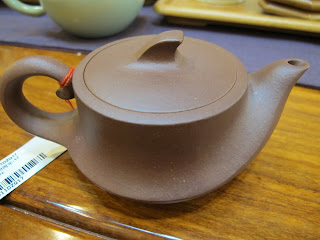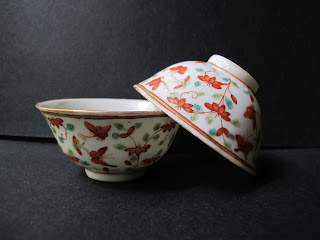Saturday, December 31, 2011
2011 - Looking Front And Back
Saturday, December 24, 2011
Yoda drinks tea - I kid you not
Wednesday, December 14, 2011
2007 Xiaguan "te-ji" 100g tuo
Sunday, December 4, 2011
2006 Yang Ji Tian Ripe Pu erh Cake
Thursday, November 24, 2011
Pu erh news - Hong Kong
Saturday, November 19, 2011
Yunnan Jing Gu Black Tea
I had ordered 100g of this black tea from Yunnan Sourcing. This black tea comes from Jing-Gu and the black tea leaves looks golden. It has a nice strong sweet scent but I would suggest you do not brew this tea in a your clay teapot as the aroma, even though is very nice, may linger in your pot for some time and will affect the tea brew when you re-use the teapot for other teas. I suggest you use something ceramic when you brew any scented tea. Dedicate one teapot if you really like a particular strong scented tea. I have a separate yixing teapot for heavy roasted TGY and shui xian.
For convenience, I recommend you take a pinch (about 10 strands) and brew in your mug. Add hot water (a couple of minutes after boiling) and your tea is ready to drink in 5 minutes. This black tea releases a nice nectar sweet aroma. The color of a brewed tea is like a weak ripe pu erh brew. The aroma makes me think the tea is sweet when I drink the tea. Very nice and pleasant. This black tea also makes a nice chilled tea as well.
Costing about $10 for 100g (its quite a lot of tea leaves and will last a long time), I would recommend you include a pack of this Jing-Gu black tea when you place your next order with Yunnan Sourcing.
Saturday, November 12, 2011
2005 Haiwan 'Yellow Label' Ripe Pu erh 357g



Friday, November 4, 2011
The "Lau Yu Fat teapot"





Tuesday, October 25, 2011
Asian Geographic - coffee and tea edition






Saturday, October 15, 2011
2005 LangHe Ripe Pu erh 357g




Saturday, October 8, 2011
Straits Chinese Porcelain Teacups Pt.2




Saturday, October 1, 2011
Earl Grey - New vs Old

Alan Watkins wrote a very thought provoking tea article, on 29 Aug 2011 in the Daily Mail. Text and picture from the following website: (http://www.dailymail.co.uk/news/article-2030922/Earl-Grey-drinkers-dismiss-new-recipe-affront-tea.html)
We're pining for our old Twinings: Furious Earl Grey drinkers dismiss new recipe as 'an affront to tea
It is the company credited with transforming tea into the nation’s favourite tipple more than 300 years ago.
But now Twinings has provoked the ultimate storm in a teacup by tampering with one of its best-known and most cherished blends.
Fans of the company’s Earl Grey tea are furious that the firm has altered the traditional flavouring and relaunched it as The Earl Grey.
Trouble brewing: The original Earl Grey which customers say they want back
They say the new product tastes like ‘lemon cleaning product’ and describe it as ‘dishwater’ served up in a cup.
Dozens of angry tea drinkers have posted complaints about the new flavour on the company’s website since the new brand was launched in April.
One wrote: ‘I cannot describe how awful this new tea tastes. The old award-winning tea was in a completely different league to this foul-tasting dishwater.’
Others have simply described the new product as ‘horrid’, ‘vile’ and ‘an affront to tea’.
One wrote: ‘I agree with the other posts here that the new Earl Grey is an awful disappointment!
‘Bring back the old recipe that was refreshing and flavoursome.’
Some tea drinkers are so dismayed by the new blend they have added their names to a Facebook campaign called ‘Bring Back the Original Twinings Earl Grey Tea’.
Several have enquired on the campaign page where you can find old stock of the original Twinings Earl Grey on supermarket shelves.
Twinings, which was founded by Thomas Twining after he opened a tea room on the Strand in London in 1706, is generally acknowledged to have been the first company to sell the first brand of Earl Grey tea.
It launched the blend in 1831, naming it after the Prime Minister of the day, Charles Grey. The distinctive taste is created by infusing black tea with the oil of the bergamot orange from South-East Asia.
Though Twinings was first to market Earl Grey, its origins have been disputed for nearly 200 years.
According to one story, the blend was first created by accident when a gift of tea and bergamot oranges was made to Earl Grey from diplomats in China and the tea absorbed the flavour of the oranges during its journey by sea from Asia.
Others say Earl Grey was gifted the recipe for the blend by a visiting Chinese dignitary.
Twinings’ new The Earl Grey contains extra bergamot and citrus.
According to the company’s website the product has been ‘refreshed’ with an ‘additional hint of bergamot’.
Alex Probyn, a master tea blender who runs the firm Blends for Friends, said: ‘You are talking about changing a product that people have been drinking for decades. A reaction is inevitable.’
A spokesman for Twinings insisted it had carried out extensive market research before implementing the changes.
He said: ‘As with all changes to blends, our new Earl Grey has undergone rigorous consumer tasting, receiving strong preference feedback over the previous blend.’
Saturday, September 24, 2011
2006 Hong Tai Chang Ripe Pu erh Cake



Sunday, September 18, 2011
The Lady Tasting Tea

“It was a summer afternoon in Cambridge, England in the late 1920s. A group of university dons, their wives, and some guests were sitting around and outdoor table for afternoon tea. One of the women was insisting that tea tasted different depending upon whether the tea was poured into the milk or whether the milk was poured into the tea. The scientific minds among the men scoffed at this as sheer nonsense. What could be the difference? They could not conceive of any difference in the chemistry of the mixtures that could exist. A thin, short man, with thick glasses and a Vandyke beard beginning to turn gray, pounced on the problem.
“Let us test the proposition” he said excitedly. He began to outline an experiment in which the lady insisted there was a difference would be presented with a sequence of cups of tea, in some of which the milk had been poured into the tea and in others of which the tea had been poured into the milk.”
This were the opening lines to chapter 1 of the book “The Lady Tasting Tea”. Published by Holt paperbacks, 2001, this book explained the birth and evolution of the use of statistics in science. And, tea, was an indirect participant, in one of the earliest use of statistics in a scientific finding. Even though statistics itself is boring, the author, David Salsburg, made this book highly readable and entertaining. A fun and informative read. Below are a couple more excerpts from the book:
“…..The man with the Vandyke beard was Ronald Aylmer Fischer, who was in his late thirties at the time. He would later be knighted Sir Ronald Fischer. In 1935, he wrote a book entitled The design of Experiments, and he described the experiment of the lady tasting tea in the second chapter of that book. In his book, Fischer discusses the lady and her belief as a hypothetical problem. He considers the various ways in which an experiment might be designed to determine if she could tell the difference. The problem in designing the experiment is that, if she is given a single cup of tea, she has a 50 percent chance of guessing correctly which infusion was served, even if she cannot tell the difference. If she is given two cups of tea, she might guess correctly. In fact, if she knew that the two cups of tea were each made with a different infusion, one guess could be completely right (or completely wrong).
Monday, September 12, 2011
The state of mooncakes and chinese tea





Friday, September 2, 2011
2005 Ai Lao Shan Raw Pu erh 357g














